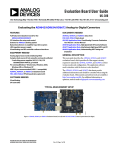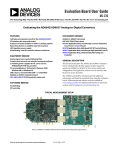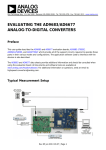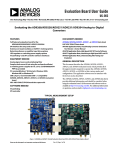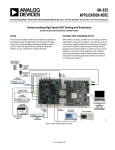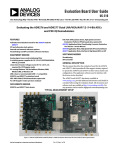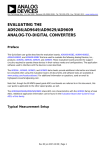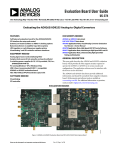Download Evaluation Board User Guide
Transcript
Evaluation Board User Guide UG-293 One Technology Way • P.O. Box 9106 • Norwood, MA 02062-9106, U.S.A. • Tel: 781.329.4700 • Fax: 781.461.3113 • www.analog.com Evaluating the AD9643/AD9613/AD6649/AD6643 Analog-to-Digital Converters FEATURES DOCUMENTS NEEDED Full featured evaluation board for the AD9643/AD9613/AD6649/AD6643 SPI interface for setup and control External or AD9523 clocking option Balun/transformer or amplifier input drive options LDO regulator power supply VisualAnalog and SPI controller software interfaces AD9643, AD9613, AD6649, or AD6643 data sheet HSC-ADC-EVALCZ data sheet AN-905 Application Note, VisualAnalog Converter Evaluation Tool Version 1.0 User Manual AN-878 Application Note, High Speed ADC SPI Control Software AN-877 Application Note, Interfacing to High Speed ADCs via SPI AN-835 Application Note, Understanding ADC Testing and Evaluation EQUIPMENT NEEDED Analog signal source and antialiasing filter Sample clock source (if not using the on-board oscillator) 2 switching power supplies (6.0 V, 2.5 A), CUI EPS060250UHPHP-SZ, provided PC running Windows® 98 (2nd ed.), Windows 2000, Windows ME, or Windows XP USB 2.0 port recommended (USB 1.1 compatible) AD9643, AD9613, AD6649, or AD6643 evaluation board HSC-ADC-EVALCZ FPGA-based data capture kit SOFTWARE NEEDED VisualAnalog SPI controller GENERAL DESCRIPTION This user guide describes the AD9643, AD9613, AD6649, and AD6643 evaluation board, which provides all of the support circuitry required to operate the AD9643, AD9613, AD6649, and AD6643 in their various modes and configurations. The application software used to interface with the devices is also described. The AD9643, AD9613, AD6649, and AD6643 data sheets provide additional information and should be consulted when using the evaluation board. All documents and software tools are available at http://www.analog.com/fifo. For additional information or questions, send an email to [email protected]. 09940-001 TYPICAL MEASUREMENT SETUP Figure 1. AD9643, AD9613, AD6649, or AD6643 Family Evaluation Board and HSC-ADC-EVALCZ Data Capture Board PLEASE SEE THE LAST PAGE FOR AN IMPORTANT WARNING AND LEGAL TERMS AND CONDITIONS. Rev. 0 | Page 1 of 28 UG-293 Evaluation Board User Guide TABLE OF CONTENTS Features .............................................................................................. 1 Output Signals ...............................................................................4 Equipment Needed........................................................................... 1 Default Operation and Jumper Selection Settings....................4 Software Needed ............................................................................... 1 Evaluation Board Software Quick Start Procedures .....................6 Documents Needed.......................................................................... 1 Configuring the Board .................................................................6 General Description ......................................................................... 1 Using the Software for Testing.....................................................6 Typical Measurement Setup ............................................................ 1 Evaluation Board Schematics and Artwork................................ 14 Revision History ............................................................................... 2 Ordering Information.................................................................... 24 Evaluation Board Hardware ............................................................ 3 Bill of Materials........................................................................... 24 Power Supplies .............................................................................. 3 Related Links................................................................................... 27 Input Signals.................................................................................. 3 REVISION HISTORY 11/11—Revision 0: Initial Version Rev. 0 | Page 2 of 28 Evaluation Board User Guide UG-293 EVALUATION BOARD HARDWARE The AD9643, AD9613, AD6649, or AD6643 evaluation board provides all of the support circuitry required to operate these parts in their various modes and configurations. Figure 2 shows the typical bench characterization setup used to evaluate the ac performance of the AD9643, AD9613, AD6649, or AD6643. It is critical that the signal sources used for the analog input and the clock have very low phase noise (<1 ps rms jitter) to realize the optimum performance of the signal chain. Proper filtering of the analog input signal to remove harmonics and lower the integrated or broadband noise at the input is necessary to achieve the specified noise performance. See the Evaluation Board Software Quick Start Procedures section to get started, and see Figure 23 to Figure 34 for the complete schematics and layout diagrams. These diagrams demonstrate the routing and grounding techniques that should be applied at the system level when designing application boards using these converters. POWER SUPPLIES This evaluation board comes with a wall-mountable switching power supply that provides a 6 V, 2 A maximum output. Connect the supply to a rated 100 V ac to 240 V ac wall outlet at 47 Hz to 63 Hz. The output from the supply is provided through a 2.1 mm inner diameter jack that connects to the printed circuit board (PCB) at P201. The 6 V supply is fused and conditioned on the PCB before connecting to the low dropout linear regulators (default configuration) that supply the proper bias to each of the various sections on the board. WALL OUTLET 100V TO 240V AC 47Hz TO 63Hz SIGNAL SYNTHESIZER The evaluation board can be powered in a nondefault condition using external bench power supplies. To do this, remove the jumpers on the P103, P104, P107, P108, and P105 header pins to disconnect the outputs from the on-board LDOs. This enables the user to bias each section of the board individually. Use P202 and P203 to connect a different supply for each section. A 1.8 V supply is needed with a 1 A current capability for DUT_AVDD and DRVDD; however, it is recommended that separate supplies be used for both analog and digital domains. An additional supply is also required to supply 1.8 V for digital support circuitry on the board, DVDD. This should also have a 1 A current capability and can be combined with DRVDD with little or no degradation in performance. To operate the evaluation board using the SPI and alternate clock options, a separate 3.3 V analog supply is needed in addition to the other supplies. This 3.3 V supply, or 3P3V_ANALOG, should have a 1 A current capability. This 3.3 V supply is also used to support the optional input path amplifier (ADL5202) on Channel A and Channel B. INPUT SIGNALS When connecting the clock and analog source, use clean signal generators with low phase noise, such as the Rohde & Schwarz SMA or HP 8644B signal generators or an equivalent. Use a 1 m shielded, RG-58, 50 Ω coaxial cable for connecting to the evaluation board. Enter the desired frequency and amplitude (see the Specifications section in the data sheet of the respective part). SWITCHING POWER SUPPLY SWITCHING POWER SUPPLY 6V DC 2A MAX ANALOG INPUT 6V DC 2A MAX SIGNAL SYNTHESIZER ANALOG INPUT OPTIONAL CLOCK SOURCE Figure 2. Evaluation Board Connection Rev. 0 | Page 3 of 28 09940-002 SIGNAL SYNTHESIZER PC RUNNING ADC ANALYZER OR VISUAL ANALOG USER SOFTWARE UG-293 Evaluation Board User Guide and out of the ADL5202 can be configured in many different ways depending on the application; therefore, the parts in the input and output path are left unpopulated. Users should see the ADL5202 data sheet for additional information on this part and for configuring the inputs and outputs. The ADL5202, by default, is held in power-down mode but can be enabled by adding 1 kΩ resistors at R427 and R428 to enable Channel A and Channel B, respectively. When connecting the analog input source, use of a multipole, narrow-band, band-pass filter with 50 Ω terminations is recommended. Analog Devices, Inc., uses TTE and K&L Microwave, Inc., band-pass filters. The filters should be connected directly to the evaluation board. If an external clock source is used, it should also be supplied with a clean signal generator as previously specified. Typically, most Analog Devices evaluation boards can accept ~2.8 V p-p or 13 dBm sine wave input for the clock. Clock Circuitry DEFAULT OPERATION AND JUMPER SELECTION SETTINGS The default clock input circuit that is populated on the AD9643/ AD9613/AD6649/AD6643 evaluation board uses a simple transformer-coupled circuit with a high bandwidth 1:1 impedance ratio transformer (T503) that adds a very low amount of jitter to the clock path. The clock input is 50 Ω terminated and ac-coupled to handle single-ended sine wave types of inputs. The transformer converts the single-ended input to a differential signal that is clipped by CR503 before entering the ADC clock inputs. This section explains the default and optional settings or modes allowed on the AD9643/AD9613/AD6649/AD6643 evaluation board. The board is set by default to use an external clock generator. An external clock source capable of driving a 50 Ω terminated input should be connected to J506. Power Circuitry A differential LVPECL clock driver output can also be used to clock the ADC input using the AD9523 (U501). To place the AD9523 into the clock path, populate R541 and R542 with 0 Ω resistors and remove C532 and C533 to disconnect the default clock path inputs. In addition, populate R533 and R534 with 0 Ω resistors, remove R522 and R523 to disconnect the default clock path outputs, and insert AD9523 LVPECL Output 2. The AD9523 must be configured through the SPI controller software to set up the PLL and other operation modes. Consult the AD9523 data sheet for more information about these and other options. OUTPUT SIGNALS The default setup uses the Analog Devices high speed converter evaluation platform (HSC-ADC-EVALCZ) for data capture. The output signals from Channel A and Channel B for the AD9643, AD9613, AD6649, and AD6643 are routed through P601 and P602, respectively, to the FPGA on the data capture board. Connect the switching power supply that is supplied in the evaluation kit between a rated 100 V ac to 240 V ac wall outlet at 47 Hz to 63 Hz and P201. Analog Input The A and B channel inputs on the evaluation board are set up for a double balun-coupled analog input with a 50 Ω impedance. This input network is optimized to support a wide frequency band. See the AD9643, AD9613, AD6649, and AD6643 data sheets for additional information on the recommended networks for different input frequency ranges. The nominal input drive level is 10 dBm to achieve 2 V p-p full scale into 50 Ω. At higher input frequencies, slightly higher input drive levels are required due to losses in the front-end network. PDWN To enable the power-down feature, add a shorting jumper across P101 at Pin 1 and Pin 2 to connect the PDWN pin to AVDD. OEB Optionally, Channel A and Channel B inputs on the board can be configured to use the ADL5202 digitally controlled, variable gain wide bandwidth amplifier. The ADL5202 component is included on the evaluation board at U401. However, the path into To disable the digital output pins and place them in a high impedance state, add a shorting jumper across P102 at Pin 1 and Pin 2 to connect the OEB pin to AVDD. 8.2pF 0.1µF 2V p-p 33Ω 49.9Ω VIN+x 36Ω PA S S P AD9643/AD9613/ AD6649/AD6643 8.2pF 0.1µF 36Ω 0.1µF 33Ω VIN–x VCM Figure 3. Default Analog Input Configuration of the AD9643/AD9613/AD6649/AD6643 Rev. 0 | Page 4 of 28 09940-003 49.9Ω 8.2pF Evaluation Board User Guide UG-293 Switching Power Supply Optionally, the ADC on the board can be configured to use the ADP2114 dual switching power supply to provide power to the DRVDD and AVDD rails of the ADC. To configure the board to operate from the ADP2114, the following changes must be incorporated (see the Evaluation Board Schematics and Artwork and the Bill of Materials sections for specific recommendations for part values): 1. 2. Install R204 and R221 to enable the ADP2114. Install R216 and R218. 3. 4. 5. 6. Install L201 and L202. Remove JP201 and JP203. Remove jumpers from across Pin 1 and Pin 2 on P107 and P108, respectively. Place jumpers across Pin 1 and Pin 2 of P106 and P109, respectively. Making these changes enables the switching converter to power the ADC. Using the switching converter as the ADC power source is more efficient than using the default LDOs. Rev. 0 | Page 5 of 28 UG-293 Evaluation Board User Guide EVALUATION BOARD SOFTWARE QUICK START PROCEDURES This section provides quick start procedures for using the AD9643/ AD9613/AD6649/AD6643 evaluation board. Both the default and optional settings are described. CONFIGURING THE BOARD 3. 4. 5. 6. 7. USING THE SOFTWARE FOR TESTING Figure 4. VisualAnalog, New Canvas Window 2. Figure 5. VisualAnalog Default Configuration Message 3. Setting Up the ADC Data Capture After configuring the board, set up the ADC data capture using the following steps: 1. After the template is selected, a message appears asking if the default configuration can be used to program the FPGA (see Figure 5). Click Yes, and the window closes. 09940-005 2. Connect the evaluation board to the data capture board, as shown in Figure 1 and Figure 2. Connect one 6 V, 2.5 A switching power supply (such as the CUI, Inc., EPS060250UH-PHP-SZ that is supplied) to the AD9643/AD9613/AD6649/AD6643 board. Connect another 6 V, 2.5 A switching power supply (such as the CUI EPS060250UH-PHP-SZ that is supplied) to the HSC-ADC-EVALCZ board. Connect the HSC-ADC-EVALCZ board (J6) to the PC with a USB cable. On the ADC evaluation board, confirm that jumpers are installed on the P105, P108, P104, P107, P110, and P103 headers. Connect a low jitter sample clock to Connector J506. Use a clean signal generator with low phase noise to provide an input signal to the desired channel(s) at Connector J301 (Channel A) and/or Connector J303 (Channel B). Use a 1 m, shielded, RG-58, 50 Ω coaxial cable to connect the signal generator. For best results, use a narrow-band bandpass filter with 50 Ω terminations and an appropriate center frequency. (Analog Devices uses TTE, Allen Avionics, and K&L band-pass filters.) Open VisualAnalog® on the connected PC. The appropriate part type should be listed in the status bar of the VisualAnalog – New Canvas window. Select the template that corresponds to the type of testing to be performed (see Figure 4 where the AD9643 is shown as an example). The AD9643 is given as an example in this user guide. Similar settings are used for the AD9613. For the AD6649 and AD6643, the differences are noted where necessary in the steps that follow. To change features to settings other than the default settings, click the Expand Display button, located on the bottom right corner of the window, to see what is shown in Figure 7. Detailed instructions for changing the features and capture settings can be found in the AN-905 Application Note, VisualAnalog™ Converter Evaluation Tool Version 1.0 User Manual. After the changes are made to the capture settings, click the Collapse Display button (see Figure 6). 09940-006 1. 09940-004 Before using the software for testing, configure the evaluation board as follows: Figure 6. VisualAnalog Window Toolbar, Collapsed Display Rev. 0 | Page 6 of 28 UG-293 09940-007 Evaluation Board User Guide Figure 7. VisualAnalog, Main Window Setting Up the SPI Controller Software 1. Open the SPI controller software by going to the Start menu or by double-clicking the SPIController software desktop icon. If prompted for a configuration file, select the appropriate one. If not, check the title bar of the window to determine which configuration is loaded. If necessary, choose Cfg Open from the File menu and select the appropriate file based on your part type. Note that the CHIP ID(1) field should be filled to indicate whether the correct SPI controller configuration file is loaded (see Figure 8). Rev. 0 | Page 7 of 28 09940-008 After the ADC data capture board setup is complete, set up the SPI controller software using the following procedure: Figure 8. SPI Controller, CHIP ID(1) Section UG-293 5. Click the New DUT button in the SPIController window (see Figure 9). Note that other settings can be changed on the ADCBase 0 tab (see Figure 11) and the ADC A and ADC B tabs (see Figure 10) to set up the part in the desired mode. The settings on the ADCBase 0 tab affect the entire part, whereas the settings on the ADC A and ADC pages affect the selected channel only. See the appropriate part data sheet; the AN-878 Application Note, High Speed ADC SPI Control Software; and the AN-877 Application Note, Interfacing to High Speed ADCs via SPI, for additional information on the available settings. 09940-009 2. Evaluation Board User Guide 4. In the ADCBase 0 tab of the SPIController window, find the CLK DIV(B) section (see Figure 11). If using the clock divider, use the drop-down box to select the correct clock divide ratio, if necessary. See the appropriate part data sheet; the AN-878 Application Note, High Speed ADC SPI Control Software; and the AN-877 Application Note, Interfacing to High Speed ADCs via SPI, for additional information. In the ADCBase 0 tab of the SPIController window, find the FLEX OUTPUT DELAY(17) box. Select the DCO Clk Delay Enable checkbox to enable this feature. In the drop-down box, select 600 ps additional delay on DCO pin. These settings align the output timing with the input timing on the capture FPGA. Figure 10. SPI Controller, Example ADC A Tab 09940-010 3. 09940-011 Figure 9. SPI Controller, New DUT Button Figure 11. SPI Controller, CLK DIV(B) Section Rev. 0 | Page 8 of 28 Evaluation Board User Guide If using the AD6649, the device can be configured into two different modes. The default mode utilizes a 95 MHz FIR filter and fixed-frequency NCO. The SPI controller settings for this mode are shown in Figure 12. Under the MAIN(50) section, the Fir Low Latency Mode En checkbox must be selected and the Low Latency NCO (Fs/4 Only) option must be clicked under the MISC EXTRA(5A) section. The second mode uses a 100 MHz FIR filter and a tunablefrequency NCO (see Figure 13). In this mode, the High Latency NCO option under MISC EXTRA(5A) must be clicked and the Fir Low Latency Mode En checkbox must be cleared under the MAIN(50) section. 09940-012 6. UG-293 Figure 12. SPI Controller, AD6649 ADC A Tab—95 MHz FIR Filter and Fixed-Frequency NCO Mode Rev. 0 | Page 9 of 28 Evaluation Board User Guide 09940-013 UG-293 09940-014 Figure 13. SPI Controller, AD6649 ADC A Tab—95 MHz FIR Filter and Fixed-Frequency NCO Mode Figure 14. SPI Controller, Example ADC A Tab—NSR Settings for the AD6643 If using the Noise Shaping Requantizer (NSR) feature of the AD6643, the settings in the ADC A and/or ADC B pages must be changed (see Figure 14). The NSR Enable checkbox must be selected under the NOISE SHAPED REQUANTIZER 1(3C) section. This enables the circuitry in the AD6643. To select the bandwidth mode, select 0 for 22% and 1 for 33% under the NSR Mode drop-down menu in the NOISE SHAPED REQUANTIZER 1(3C) section. Upon selecting the bandwidth mode, select the desired tuning word in the NSR Tuning drop-down menu under 8. Rev. 0 | Page 10 of 28 the NOISE SHAPED REQUANTIZER TUNING(3E) section. Click the Run button in the VisualAnalog toolbar (see Figure 15). 09940-015 7. Figure 15. Run Button (Encircled in Red) in VisualAnalog Toolbar, Collapsed Display Evaluation Board User Guide UG-293 0 Adjusting the Amplitude of the Input Signal 250MSPS 90.1MHz @ –1dBFS –20 SNR = 70.6dB (71.6dBFS) SFDR = 88dBc The next step is to adjust the amplitude of the input signal for each channel as follows: –40 –60 THIRD HARMONIC SECOND HARMONIC –80 –100 –120 0 10 20 30 40 50 60 70 80 FREQUENCY (MHz) 90 09940-017 –140 100 110 120 Figure 16. Typical FFT, AD9643 09940-016 2. 3. Adjust the amplitude of the input signal so that the fundamental is at the desired level. (Examine the Fund Power reading in the left panel of the VisualAnalog Graph window.) See Figure 17. Repeat this procedure for Channel B if desired. Click the Save disk icon within the Graph window to save the performance plot data as a .csv formatted file. See Figure 16 for an example. AMPLITUDE (dBFS) 1. Figure 17. Graph Window of VisualAnalog (AD9643) Rev. 0 | Page 11 of 28 UG-293 09940-019 If operating the AD6649 in the mode using the 95 MHz FIR filter and fixed-frequency NCO, the amplitude displayed is −2.5 dBFS for a −1.0 dBFS input signal (see Figure 18) to the desired settings. If operating the AD6649 in the mode utilizing the 100 MHz FIR filter and tunablefrequency NCO, the amplitude displayed is −1.3 dBFS for a −1.0 dBFS input signal (see Figure 19). Figure 19. Visual Graph Window of VisualAnalog (AD6649)—100 MHz FIR Filter and Tunable-Frequency NCO Mode 5. 6. 09940-018 Repeat Step 3 to save the graph in a .csv file format. If operating the AD6643 with NSR enabled, certain options in VisualAnalog must be enabled. Click the button circled in the FFT Analysis box (see Figure 20) in VisualAnalog to bring up the options for setting the NSR. Figure 18. Visual Graph Window of VisualAnalog (AD6649)—95 MHz FIR Filter and Fixed-Frequency NCO Mode 09940-020 4. Evaluation Board User Guide Figure 20. VisualAnalog, Main Window—Showing FFT Analysis for AD6643 Rev. 0 | Page 12 of 28 Evaluation Board User Guide 7. UG-293 Troubleshooting Tips Configure the settings in the FFT analysis to match the settings selected for the NSR in the SPI controller (see Figure 21). If the FFT plot appears abnormal, do the following: • • If you see a normal noise floor when you disconnect the signal generator from the analog input, be sure you are not overdriving the ADC. Reduce the input level, if necessary. In VisualAnalog, click the Settings button in the Input Formatter block (see Figure 7). Check that Number Format in the settings of the Input Formatter block is set to the correct encoding (offset binary by default). Repeat for the other channel. If the FFT appears normal but the performance is poor, check the following: 09940-021 • • • Figure 21. VisualAnalog, FFT Analysis Settings for AD6643 8. • The result should show an FFT plot that looks similar to Figure 22. Make sure an appropriate filter is used on the analog input. Make sure the signal generators for the clock and the analog input are clean (low phase noise). Change the analog input frequency slightly if noncoherent sampling is being used. Make sure the SPI configuration file matches the product being evaluated. If the FFT window remains blank after Run is clicked, do the following: • • 09940-022 • Figure 22. Graph Window of VisualAnalog, NSR Enabled, AD6643 9. The amplitude shows approximately 0.6 dB lower than when the NSR is disabled. The NSR circuitry introduces this loss. An amplitude of −1.6 dBFS with NSR enabled is analogous to an amplitude of −1.0 dBFS with NSR disabled. Make sure the evaluation board is securely connected to the HSC-ADC-EVALCZ board. Make sure the FPGA has been programmed by verifying that the DONE LED is illuminated on the HSC-ADCEVALCZ board. If this LED is not illuminated, make sure the U4 switch on the board is in the correct position for USB CONFIG. Make sure the correct FPGA program was installed by clicking the Settings button in the ADC Data Capture block in VisualAnalog. Then select the FPGA tab and verify that the proper FPGA bin file is selected for the part. If VisualAnalog indicates that the data capture timed out, do the following: • • 10. Repeat Step 3 to save the graph in a .csv file format. Rev. 0 | Page 13 of 28 Make sure that all power and USB connections are secure. Probe the DCO signal at the ADC on the evaluation board and confirm that a clock signal is present at the ADC sampling rate. UG-293 Evaluation Board User Guide EVALUATION BOARD SCHEMATICS AND ARTWORK 09940-023 Figure 23. DUT and Related Circuits Rev. 0 | Page 14 of 28 Evaluation Board User Guide UG-293 09940-024 Figure 24. Board Power Input and Supply Rev. 0 | Page 15 of 28 UG-293 Evaluation Board User Guide 09940-025 Figure 25. Passive Analog Input Circuits Rev. 0 | Page 16 of 28 Evaluation Board User Guide UG-293 09940-026 Figure 26. Optional Active Input Circuits Rev. 0 | Page 17 of 28 UG-293 Evaluation Board User Guide 09940-027 Figure 27. Default and Optional Clock Input Circuits Rev. 0 | Page 18 of 28 Evaluation Board User Guide UG-293 09940-028 Figure 28. SPI Configuration Circuit and FIFO Board Connector Circuit Rev. 0 | Page 19 of 28 Evaluation Board User Guide 09940-029 UG-293 Figure 29. Top Side Rev. 0 | Page 20 of 28 UG-293 09940-030 Evaluation Board User Guide 09940-031 Figure 30. Ground Plane (Layer 2) Figure 31. Power Plane (Layer 3) Rev. 0 | Page 21 of 28 Evaluation Board User Guide 09940-032 UG-293 09940-033 Figure 32. Power Plane (Layer 4) Figure 33. Ground Plane (Layer 5) Rev. 0 | Page 22 of 28 UG-293 09940-034 Evaluation Board User Guide Figure 34. Bottom Side Rev. 0 | Page 23 of 28 UG-293 Evaluation Board User Guide ORDERING INFORMATION BILL OF MATERIALS Table 1. AD9643/AD9613/AD6649/AD6643 Bill of Materials Item 1 Qty 1 Reference Designator N/A 2 16 3 4 6 50 5 6 6 12 7 8 6 1 C101, C102, C103, C105, C109, C110, C111, C112, C113, C114, C115, C514, C515, C516, C520, C521 C107, C117, C118, C121, C122, C212 C123, C231, C233, C235, C237, C239, C301, C305, C306, C307, C311, C312, C401, C402, C403, C404, C405, C406, C407, C408, C409, C411, C413, C414, C419, C501, C502, C504, C505, C506, C507, C517, C518, C519, C535, C536, C537, C538, C539, C540, C541, C542, C543, C544, C545, C546, C547, C548, C601, C604 C201, C232, C234, C236, C238, C240 C202, C203, C204, C206, C207, C209, C225, C227, C228, C230, C241, C243 C210, C211, C220, C221, C223, C224 C213 9 2 C214, C216 10 11 12 13 14 1 4 2 4 8 15 16 17 18 2 1 3 3 C215 C217, C218, C226, C229 C302, C308 C303, C304, C309, C310 C410, C412, C524, C525, C526, C527, C530, C534 C503, C508 C510 C511, C512, C513 C523, C532, C533 19 20 21 22 1 1 3 3 CR201 CR202 CR203, CR501, CR502 CR204, CR205, CR206 23 24 1 15 25 26 2 1 CR503 E201, E202, E204, E205, E207, E208, E209, E210, E211, E212, E213, E214, E215, E216, E217 E501, E502 F201 27 1 FL201 28 29 30 31 32 4 2 4 6 10 J101, J301, J303, J506 JP201, JP203 L401, L402, L407, L408 L501, L502, L503, L504, L505, L506 P101, P102, P103, P104, P105, P106, P107, P108, P109, P110 Description Printed circuit board, AD9643 engineering board 0.1 μF capacitor ceramic X5R 0201 Manufacturer/Part No. 9643EE01 1 μF capacitor monolithic ceramic 0402 0.1 μF capacitor ceramic X7R 0402 Murata GRM155R60J105KE19D Murata GRM155R71C104KA88D 10 μF capacitor tantalum 4.7 μF capacitor monolithic ceramic X5R AVX TAJA106K010RNJ Murata GRM188R60J475KE19 22 μF capacitor ceramic chip 2200 pF capacitor ceramic X7R 0402 Murata GRM21BR60J226ME39L Phycomp (Yageo) CC0402KRX7R9BB222 Murata GRM1555C1H101JD01D 100 pF capacitor chip mono ceramic C0G 0402 1500 pF capacitor ceramic X7R 0402 0.01 μF capacitor ceramic X7R 0402 3.9 pF capacitor ceramic NP0 0402 8.2 pF capacitor ceramic NP0 0402 10 μF capacitor ceramic monolithic 0.33 μF capacitor ceramic X5R 0.001 μF capacitor ceramic monolithic 0.47 μF capacitor chip ceramic X7R 0603 390 pF capacitor chip monolithic ceramic C0G 0402 Diode rectifier GPP SMD Diode Schottky 3-amp rectifier LED green surface-mount Diode recovery rectifier Diode Schottky dual series 100 MHZ inductor ferrite bead 45 Ω chip bead core 1.1 A fuse poly-switch PTC device 1812 Filter noise suppression LC combined type Connector-PCB SMA ST edge mount 0 Ω resistor jumper SMD 0805 (SHRT) 1 μH inductor SM 1 μH inductor SMT power Connector-PCB header 2-position Rev. 0 | Page 24 of 28 Murata GRM033R60J104KE19D Murata GRM155R71H152KA01D Murata GRM155R71H103KA01D Murata GRM1555C1H3R9CZ01D YAGEO 0402CG829D9B200 Murata GRM21BR61C106KE15L Murata GRM155R61A334KE15D Murata GRM155R71H102KA01D Murata GCM188R71C474KA55D Murata GRM1555C1H391JA01D Diode, Inc. S1AB-13 MCC SK33A-TP Panasonic LNJ314G8TRA Micro Commercial Components CORP S2A-TP Avago HSMS-2812BLK Panasonic EXC-ML20A390U Panasonic EXCCL3225U1 Tyco Electronics NANOSMDC110F-2 Murata BNX016-01 Samtec SMA-J-P-X-ST-EM1 Panasonic ERJ-6GEYJ0.0 Coilcraft 0603LS-102XGLB Coilcraft ME3220-102MLB Samtec TSW-102-08-G-S Evaluation Board User Guide Item 33 34 35 36 Qty 1 1 1 1 Reference Designator P201 P202 P203 P400 37 38 2 18 39 1 P601, P602 C528, R101, R217, R219, R401, R402, R439, R440, R441, R442, R506, R522, R523, R537, R606, R613, R616, R628 R201 40 22 41 2 42 14 43 44 5 5 R205, R222, R427, R428, R429, R430, R431, R432, R434, R445, R502, R603, R605, R626 R206, R319, R320, R339, R340 R207, R208, R602, R611, R612 46 1 1 R209 R210 47 48 49 2 1 1 R211, R212 R213 R214 50 51 52 53 4 4 4 8 54 13 55 2 R302, R303, R539, R540 R313, R314, R333, R334 R315, R316, R335, R336 R317, R318, R337, R338, R501, R503, R505, R604 R510, R511, R524, R525, R526, R527, R531, R532, R535, R536, R544, R545, R546 R513, R514 56 57 6 1 T302, T303, T306, T307, T501, T503 U1010 58 1 U201 59 2 U202, U203 60 2 U204, U205 61 1 U206 62 1 U207 63 64 651 661 2 1 U300, U602 U601 C125 C126, C313, C314, C441, C442, C522, C529, C602, C603 C205, C208, C242 671 R202, R409, R413, R416, R417, R418, R419, R420, R421, R422, R423, R424, R425, R509, R515, R516, R518, R519, R601, R609, R610, R615 R103, R203 UG-293 Description Connector-PCB DC power jack SM Connector-PCB header 6-position Connector-PCB, pluggable header Connector-PCB BERG header ST male 3pin Connector-PCB 60-pin RA connector 0 Ω resistor film SMD 0402 Manufacturer/Part No. CUI, Inc. PJ-202A Wieland Z5.531.3625.0 Wieland Z5.531.3425.0 Samtec TSW-103-08-G-S 261 Ω resistor film chip thick NIC Components Corp NRC06F2610TRF Panasonic ERJ-2RKF1002X 10 kΩ resistor PREC thick film chip R0402 1.91 kΩ resistor PREC thick film chip R0402 1.00 kΩ resistor PREC thick film chip R0402 10 Ω resistor PREC thick film chip R0402 100 kΩ resistor PREC thick film chip R0402 27 kΩ resistor CHIP SMD 0402 4.64 kΩ resistor PREC thick film chip R0402 15 kΩ resistor chip SMD 0402 13 kΩ resistor film SMD 0402 10.5 kΩ resistor PREC thick film chip R0402 33 Ω resistor film SMD 0402 36 Ω resistor film SMD 0402 15.0 Ω resistor film SMD 0402 49.9 Ω resistor PREC thick film chip R0402 100 Ω resistor PREC thick film chip R0201 200 Ω resistor PREC thick film chip R0402 XFMR RF 1:1 SKT 64-pin LFCSP Tyco 6469169-1 Panasonic ERJ-2GE0R00X Panasonic ERJ-2RKF1911X Panasonic ERJ-2RKF1001X Panasonic ERJ-2RKF10R0X Panasonic ERJ-2RKF1003X Panasonic ERJ-2RKF2702X Panasonic ERJ-2RKF4641X Panasonic ERJ-2RKF1502X Yageo 9C04021A1302FLHF3 Panasonic ERJ-2RKF1052X Panasonic ERJ-2GEJ330X Panasonic ERJ-2GEJ360X Panasonic ERJ-2RFK15R0X Panasonic ERJ-2RKF49R9X Panasonic ERJ-1GEF1000C Panasonic ERJ-2RKF2000X IC Analog Devices low dropout CMOS linear regulator IC 150 mA ultralow noise, CMOS linear regulator IC Analog Devices low dropout CMOS linear regulator IC Analog Devices dual configurable synchronous PWM step-down regulator IC 150 mA ultralow noise, CMOS linear regulator IC tiny logic UHS dual buffer IC tiny logic UHS dual buffer 1 μF capacitor monolithic ceramic 0402 0.1 μF capacitor ceramic X7R 0402 M/A-COM ETC1-1-13 Analog Devices AD6649BCPZ or AD9643BCPZ Analog Devices ADP1708ARDZ-R7 Analog Devices ADP150AUJZ-3.3-R7 Analog Devices ADP1706ARDZ-1.8-R7 Analog Devices ADP2114ACPZ Analog Devices ADP150AUJZ-1.8-R7 Fairchild NC7WZ16P6X Fairchild NC7WZ07P6X Murata GRM155R60J105KE19D Murata GRM155R71C104KA88D 0.01 μF capacitor ceramic X7R 0402 Murata GRM155R71H103KA01D Rev. 0 | Page 25 of 28 UG-293 Item 681 69 1 701 711 Qty Evaluation Board User Guide Reference Designator C219, C222 C415, C416, C421, C422 C417, C423 C418, C424 Description TBD_C0603 1200 pF capacitor ceramic X7R 0402 2.7 pF capacitor ceramic 22 pF capacitor ceramic 721 731 741 751 761 771 781 791 801 C509 C531 E203, E206 J403, J404, J502, J503, J505 L201, L202 L403, L404, L405, L406, L409, L410, L411, L412 L507 R102 R104, R107, R108, R517, R627, R629 811 831 841 R105, R301, D55R321, R437, R438, R520, R521, R529, R530 R106, R109, R110, R111, R112, R204, R216, R218, R221, R311, R312, R331, R332, R403, R404, R406, R407, R410, R411, R414, R415, R508, R533, R534, R538, R541, R542, R608, R630, R631, R632 R215, R220 R405, R408 0.001 μF capacitor ceramic monolithic 12 pF capacitor ceramic C0G 0402 100 MHZ inductor ferrite bead Connector-PCB SMA ST edge mount 2.2 μH inductor SM 120 nH inductor SM 3.9 nH inductor SM 2.0 kΩ resistor film SMD 0402 10 kΩ resistor PREC thick film chip R0402 49.9 Ω resistor PREC thick film chip R0402 0 Ω resistor film SMD 0402 851 R412, R426, R443, R444 861 R433, R446 871 881 891 901 911 921 931 941 R507 R512, R633, R634, R635, R636, R637, R638, R639, R640, R641, R642, R643, R644, R645, R646, R647, R648, R649, R650 R543 T301, T305, T502 T401, T402 U401 U501 U603 951 Y501 821 1 TBD_R0603 130 Ω resistor PREC thick film chip R0402 150 Ω resistor ultra-PREC ultrareliability MF chip 1 kΩ resistor ultra-PREC ultrareliability MF chip TBD_R0402 100 Ω resistor PREC thick film chip R0201 100 Ω resistor film SMD 0402 XFMR RF XFMR RF IC-Analog Devices ADL5202 IC-Analog Devices AD9523-1 IC-Analog Devices CMOS, quad SPDT switches 60 MHz to 800 MHZ IC oscillator voltage controlled oscillator Do not install. Rev. 0 | Page 26 of 28 Manufacturer/Part No. Murata GRM155R71H122KA01D Samsung CL05C2R7CBNC Phycomp (YAGEO) 0402CG220J9B200 Murata GRM155R71H102KA01D Murata GRM1555C1H120JZ01D Panasonic EXC-ML20A390U Samtec SMA-J-P-X-ST-EM1 Toko FDV0630-2R2M Panasonic ELJ-RER12JF3 Toko LL1005-FN3N9K Multicomp CR10B202JT Panasonic ERJ-2RKF1002X Panasonic ERJ-2RKF49R9X Panasonic ERJ-2GE0R00X Panasonic ERJ-2RKF1300X Susumu RG1005P-151-B-T5 Susumu RG1005P-102-B-T5 Panasonic ERJ-1GEF1000C Venkel CR0402-16W-1000FPT Mini-Circuits ADT1-1WT+ Mini-Circuits TC3-1T+ Analog Devices ADL5202 Analog Devices AD9523-1BCPZ Analog Devices ADG734BRUZ Epson Toyocom TCO-2111 Evaluation Board User Guide UG-293 RELATED LINKS Resource AD6643 AD6649 AD9613 AD9643 ADP2114 AD9523 ADG734 AN-878 AN-877 AN-835 AN-905 Description Product Page, 14-Bit, 170/210/250 MSPS, 1.8 V Dual Analog-to-Digital Converter (ADC) Product Page, IF Diversity Receiver Product Page, 12-bit, 170/210/250 MSPS, 1.8 V Dual Analog-to-Digital Converter (ADC) Product Page, 14-Bit, 170/210/250 MSPS, 1.8 V Dual Analog-to-Digital Converter (ADC) Product Page, Configurable, Dual 2 A/Single 4 A, Synchronous Step-Down DC-to-DC Regulator Product Page, 14-Output, Low Jitter Clock generator Product Page, CMOS, 2.5 Ω Low Voltage, Quad SPDT Switch Application Note, High Speed ADC SPI Control Software Application Note, Interfacing to High Speed ADCs via SPI Application Note, Understanding ADC Testing and Evaluation Application Note, VisualAnalog™ Converter Evaluation Tool Version 1.0 User Manual Rev. 0 | Page 27 of 28 UG-293 Evaluation Board User Guide NOTES ESD Caution ESD (electrostatic discharge) sensitive device. Charged devices and circuit boards can discharge without detection. Although this product features patented or proprietary protection circuitry, damage may occur on devices subjected to high energy ESD. Therefore, proper ESD precautions should be taken to avoid performance degradation or loss of functionality. Legal Terms and Conditions By using the evaluation board discussed herein (together with any tools, components documentation or support materials, the “Evaluation Board”), you are agreeing to be bound by the terms and conditions set forth below (“Agreement”) unless you have purchased the Evaluation Board, in which case the Analog Devices Standard Terms and Conditions of Sale shall govern. Do not use the Evaluation Board until you have read and agreed to the Agreement. Your use of the Evaluation Board shall signify your acceptance of the Agreement. This Agreement is made by and between you (“Customer”) and Analog Devices, Inc. (“ADI”), with its principal place of business at One Technology Way, Norwood, MA 02062, USA. Subject to the terms and conditions of the Agreement, ADI hereby grants to Customer a free, limited, personal, temporary, non-exclusive, non-sublicensable, non-transferable license to use the Evaluation Board FOR EVALUATION PURPOSES ONLY. Customer understands and agrees that the Evaluation Board is provided for the sole and exclusive purpose referenced above, and agrees not to use the Evaluation Board for any other purpose. Furthermore, the license granted is expressly made subject to the following additional limitations: Customer shall not (i) rent, lease, display, sell, transfer, assign, sublicense, or distribute the Evaluation Board; and (ii) permit any Third Party to access the Evaluation Board. As used herein, the term “Third Party” includes any entity other than ADI, Customer, their employees, affiliates and in-house consultants. The Evaluation Board is NOT sold to Customer; all rights not expressly granted herein, including ownership of the Evaluation Board, are reserved by ADI. CONFIDENTIALITY. This Agreement and the Evaluation Board shall all be considered the confidential and proprietary information of ADI. Customer may not disclose or transfer any portion of the Evaluation Board to any other party for any reason. Upon discontinuation of use of the Evaluation Board or termination of this Agreement, Customer agrees to promptly return the Evaluation Board to ADI. ADDITIONAL RESTRICTIONS. Customer may not disassemble, decompile or reverse engineer chips on the Evaluation Board. Customer shall inform ADI of any occurred damages or any modifications or alterations it makes to the Evaluation Board, including but not limited to soldering or any other activity that affects the material content of the Evaluation Board. Modifications to the Evaluation Board must comply with applicable law, including but not limited to the RoHS Directive. TERMINATION. ADI may terminate this Agreement at any time upon giving written notice to Customer. Customer agrees to return to ADI the Evaluation Board at that time. LIMITATION OF LIABILITY. THE EVALUATION BOARD PROVIDED HEREUNDER IS PROVIDED “AS IS” AND ADI MAKES NO WARRANTIES OR REPRESENTATIONS OF ANY KIND WITH RESPECT TO IT. ADI SPECIFICALLY DISCLAIMS ANY REPRESENTATIONS, ENDORSEMENTS, GUARANTEES, OR WARRANTIES, EXPRESS OR IMPLIED, RELATED TO THE EVALUATION BOARD INCLUDING, BUT NOT LIMITED TO, THE IMPLIED WARRANTY OF MERCHANTABILITY, TITLE, FITNESS FOR A PARTICULAR PURPOSE OR NONINFRINGEMENT OF INTELLECTUAL PROPERTY RIGHTS. IN NO EVENT WILL ADI AND ITS LICENSORS BE LIABLE FOR ANY INCIDENTAL, SPECIAL, INDIRECT, OR CONSEQUENTIAL DAMAGES RESULTING FROM CUSTOMER’S POSSESSION OR USE OF THE EVALUATION BOARD, INCLUDING BUT NOT LIMITED TO LOST PROFITS, DELAY COSTS, LABOR COSTS OR LOSS OF GOODWILL. ADI’S TOTAL LIABILITY FROM ANY AND ALL CAUSES SHALL BE LIMITED TO THE AMOUNT OF ONE HUNDRED US DOLLARS ($100.00). EXPORT. Customer agrees that it will not directly or indirectly export the Evaluation Board to another country, and that it will comply with all applicable United States federal laws and regulations relating to exports. GOVERNING LAW. This Agreement shall be governed by and construed in accordance with the substantive laws of the Commonwealth of Massachusetts (excluding conflict of law rules). Any legal action regarding this Agreement will be heard in the state or federal courts having jurisdiction in Suffolk County, Massachusetts, and Customer hereby submits to the personal jurisdiction and venue of such courts. The United Nations Convention on Contracts for the International Sale of Goods shall not apply to this Agreement and is expressly disclaimed. ©2011 Analog Devices, Inc. All rights reserved. Trademarks and registered trademarks are the property of their respective owners. UG09940-0-11/11(0) Rev. 0 | Page 28 of 28




























